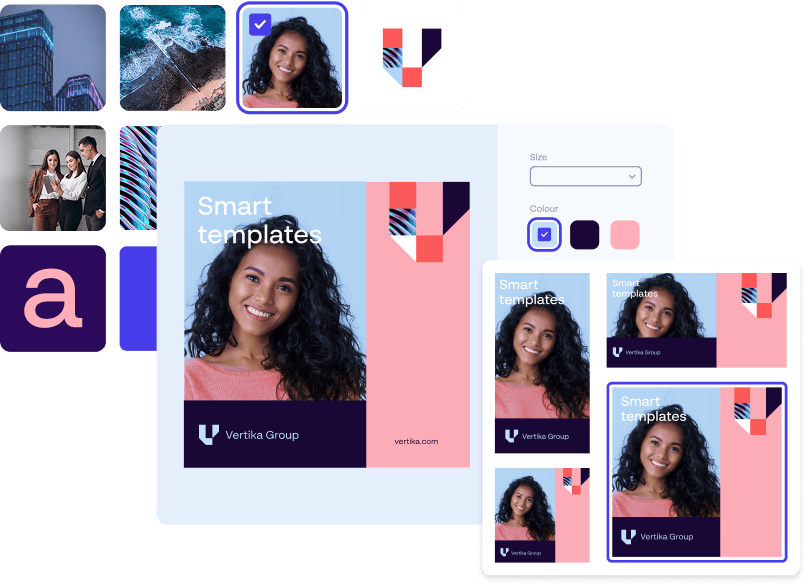Video isn’t just a nice-to-have in today’s marketing mix — it’s a core part of how brands earn attention, build trust, and convert customers. With more than 90% of 16 to 54-year-olds watching online videos every week (source: Statista), brands that fail to show up visually risk being forgotten entirely.
But showing up isn’t enough. You also need to optimize your video content by ensuring it aligns with your brand values, visual identity, and audience expectations across multiple channels and at every touchpoint.
Whether you’re just starting with video content marketing or looking to scale your efforts, these 21 proven video content ideas can help you spark engagement, tell your story, and drive demand.
#1 – Tell your brand story
Use video to shout about who you are and bring your brand values to life. A well-crafted brand video builds emotional connections with customers by showing who you are, where you’ve come from, and what matters most to your company.
#2 – Demonstrate your product
Don’t just describe your offering – show it in action. Explainer videos and product walkthroughs help viewers visualize and understand your products in ways that writing can’t always communicate.
#3 – Share customer reviews and testimonials
Social proof builds trust. So why not let satisfied customers do the talking? Sharing authentic stories of people who have used and enjoyed your products is a highly effective way to promote your brand and the benefits you offer.
#4 – Showcase user-generated content
Encourage customers to get directly involved in your video content marketing by sharing footage of themselves using your products or services. Spotlighting people who love your brand makes for great social media content as well as helping you strengthen connections with your community. Make sure you have permissions before you share.
#5 – Create thought leadership pieces
Modern B2C companies are expected to be more than just product manufacturers and sellers. Video interviews and expert POVs help position your brand as a source of insight. They also encourage viewers to learn more about you through your other channels.
#6 – Host live Q&As and webinars
Create high-value content and drive real-time engagement by hosting live discussions on a topic that’s important to your brand and your customers. This kind of video content marketing makes the audience part of the process and helps drive consumer trust in your brand. You can also repurpose the highlights for ongoing social media content.
#7 – Answer your FAQs on video
Turn static support pages into engaging, helpful video explainers. Easy to consume and easy to share, these videos provide useful content on common issues you’ve identified within your communities.
#8 – Repurpose your blog content
Take snippets and key points from your blog posts and turn them into short, snackable videos that drive more traffic to your site. A great way to share useful information, while also linking people to the original article to learn more.
#9 – Increase engagement with list-based formats
People love a list. Use countdowns, “top 5” formats, or quick wins to make educational content more engaging.
#10 – Create behind-the-scenes content
Going behind the scenes can be a highly effective way of aligning video content with marketing objectives. Use making-of footage to explain the how and why of your brand and give people the real story behind your products. This approach to creative content marketing can also help build transparency and trust.
#11 – Launch a video diary or vlog series
Vlogs are hugely popular. Why not encourage members of your own team to share moments from their day-to-day life. It’s a great way of building emotional connections with customers and giving your brand a human face.
#12 – Produce how-to guides and tutorials
Solve common problems or pain points for your audience. They don’t always need to feature your products or services – just your expertise. Example: a toy brand might produce a guide on how to create games for children using household items.
#13 – Use whiteboard video explainers
Ideal for breaking down complex concepts or product features, whiteboard videos help you educate consumers in a simple but engaging way.
#14 – Partner with influencers
Influencer collaborations can help expand your reach and boost brand credibility – as long as there is alignment with your audience and values. Proven creative content marketing ideas include unboxing videos or videos where influencers incorporate your products into their own content.
#15 – Bust common myths
Challenge misinformation in your category with fact-led, authoritative videos. Myth-busting content boosts customer trust and helps position your brand as an expert in the field.
#16 – Interviews team members or industry experts
Harness the expertise of your people and contacts by conducting thought-provoking interviews on favourite topics. Not only does this kind of video content marketing position your company as a source of knowledge for consumers – it can also provide a real boost for your employer brand.
#17 – Create relevant parodies or trend-based clips
Social media content that parodies or builds on recent trends has huge viral potential. Just make sure your video content ideas are authentic and well-timed – and always stay true to your core brand values.
#18 – Use timelapse videos to show transformation
Whether it’s a physical product or a digital process, timelapse reveals progress in a way static visuals can’t.
#19 – Run product comparisons
A tried and test form of video content marketing. Create videos that compare your products to competitor products and show customers – simply and clearly – the additional benefits your brand offers.
#20 – Experiment with VR and 360° footage
Immersive formats are especially powerful for showcasing environments, events, or new product launches.
Don’t just create content — build brand equity
Whatever formats you choose to explore, one principle remains constant: consistency.
Consistent visuals, voice and customer across every asset and in every market are the key to building brand equity.
That’s where Templated Content Creation tools can change the game. Papirfly gives your teams the power to create video content at scale, with tools that embed brand controls into every frame — so your story is told clearly, confidently, and always on-brand.
Does everyone create content that’s on‑brand, every time?
Find peace of mind with
better brand governance.
Does everyone create content that’s on‑brand, every time?
Find peace of mind with
better brand governance.
Find peace of mind with
better brand governance.

FAQs
Video has become a core channel for brand visibility, trust, and conversion, with over 90% of people aged 16–54 watch online videos weekly. Without a strong video presence, brands risk being overlooked. Video also communicates brand values and product benefits more vividly than static formats, making it a vital tool for customer engagement.
Customer reviews, testimonials, and user-generated content are among the most powerful video content ideas. They provide authentic social proof, showing real people using and loving your products. This authenticity builds credibility and emotional connection far faster than brand-led messaging alone.
Trend-based parodies, countdown lists, and behind-the-scenes footage often perform well. These formats are quick to consume and easy to share, and make your brand feel approachable. Pairing them with consistent branding across platforms strengthens recognition and recall.
Thought leadership videos, such as expert interviews, myth-busting content, or educational explainers, position your brand as a trusted authority. In a competitive market, being seen as a credible source of insight can influence buying decisions and inspire long-term loyalty.
The key is strong brand governance — maintaining consistent visuals, voice, and messaging in every asset. Templated Content Creation tools like Papirfly embed brand controls into every frame, allowing teams to scale video production without losing alignment to core brand identity.
Table of contents:
- #1 – Tell your brand story
- #2 – Demonstrate your product
- #3 – Share customer reviews and testimonials
- #4 – Showcase user-generated content
- #5 – Create thought leadership pieces
- #6 – Host live Q&As and webinars
- #7 – Answer your FAQs on video
- #8 – Repurpose your blog content
- #9 – Increase engagement with list-based formats
- #10 – Create behind-the-scenes content
- #11 – Launch a video diary or vlog series
- #12 – Produce how-to guides and tutorials
- #13 – Use whiteboard video explainers
- #14 – Partner with influencers
- #15 – Bust common myths
- #16 – Interviews team members or industry experts
- #17 – Create relevant parodies or trend-based clips
- #18 – Use timelapse videos to show transformation
- #19 – Run product comparisons
- #20 – Experiment with VR and 360° footage
- Don’t just create content — build brand equity
- FAQs


